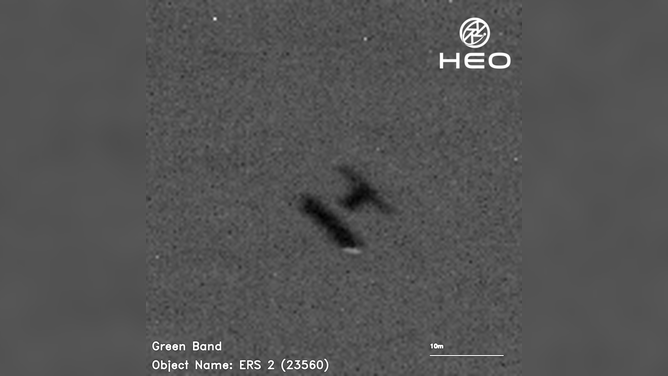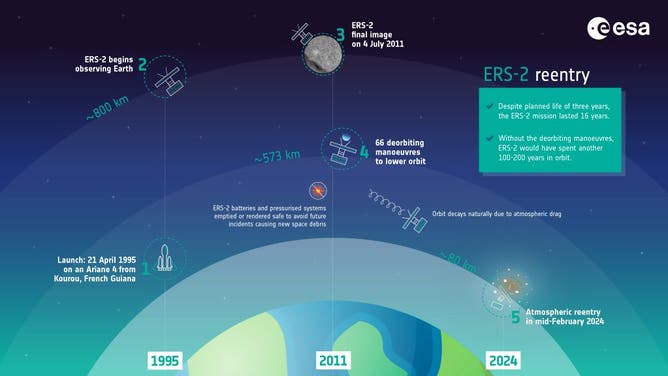School bus-sized satellite crashes into Earth's atmosphere over North Pacific Ocean
The European Space Agency's ERS-2 satellite captured data on Earth's land, oceans and polar caps, including monitoring natural disasters. According to ESA Space Debris Office, the satellite likely burned up in Earth's atmosphere over the North Pacific Ocean.
European ERS-2 satellite comes crashing back toward Earth this week
Former NASA astronaut Leroy Chiao explains what happens when a dead satellite makes a "natural" re-entry to Earth. European Space Agency's ERS-2 satellite is expected to come crashing down this week.
A defunct European Space Agency satellite the size of a school bus came crashing down to Earth on Wednesday over the North Pacific Ocean, more than a decade after the spacecraft finished its mission observing Earth's systems and natural disasters.
ESA's first advanced Earth-observing satellite, the ERS-2, launched on April 21, 1995. After studying Earth's land, oceans and polar caps for 16 years, ESA opted to end its operation in 2011 and deorbit the satellite to prevent the creation of more space debris.
Early Wednesday, the re-entry track placed the satellite over the Pacific Ocean, possibly off the West Coast of the U.S.
Hours after the re-entry window had closed, ESA operations officials confirmed the satellite had completed its crash course with Earth over the North Pacific Ocean between Alaska and Hawaii at 12:17 p.m. EST.
"At approximately 18:17 CET (17:17 UTC) on Wednesday, 21 February 2024, ESA’s ERS-2 satellite completed its atmospheric reentry over the North Pacific Ocean. No damage to property has been reported," ESA wrote.
NASA, ESA and other international aerospace community members have guidelines to reduce dead satellites and rocket parts in low-Earth orbit by requiring post-mission disposal of natural decay or a controlled entry.
"Most people nowadays and for the past several years have designed their satellites responsibly to be disposed of, responsibly and in a controlled manner," former NASA astronaut Leroy Chiao told FOX Weather. "At the end of life, spacecraft may do a deorbit burn to try to target what we call the spacecraft or satellite graveyard in the Indian Ocean, far away from shipping lanes, far away from any human activity."
EUROPE OFFICIALLY SET NEW RECORD IN 2023 FOR CONTINENT'S HOTTEST TEMPERATURE EVER
For ERS-2, mission control sent a series of commands to the 38-foot-tall satellite to lower its altitude over 66 maneuvers until it was in a passive orbit.
The large satellite was recently spotted in late January and early February, descending through Earth's atmosphere by other spacecraft in orbit. The ESA said images from HEO, an Australian company, were taken for the UK Space Agency, showing the ERS-2 satellite tumbling through the atmosphere.

ESA’s ERS-2 satellite was spotted on January 29, 2024, tumbling as it descends through the atmosphere. These images were captured by cameras on board other satellites by Australian company HEO on behalf of the UK Space Agency.
(HEO)
"The UK Space Agency recently worked with HEO to capture these images of ERS-2 during its descent," the ESA said. "Using cameras on other satellites to image objects reentering the atmosphere is a relatively new approach. In the future, these images may be used alongside data from ground-based sensors to refine reentry predictions."
A day before re-entry was expected, ESA's Earth Observation Center spotted the satellite zooming over Rome, Italy.
Tracking a satellite falling toward Earth
Over nearly 13 years, the satellite has naturally descended from its orbit about 350 miles above Earth until our planet's gravity pulls the spacecraft down and burns up in the atmosphere.

The ERS-2 satellite re-entry timeline. (Image: ESA)
(ESA)
Since the spacecraft took a "natural descent" path, ESA could not predict precisely when or where the satellite would come down on Earth but estimated it would happen in February 2024. As the satellite's demise approaches, ESA has been issuing updates.
LUNAR LANDER CAPTURES STUNNING PHOTOS OF EARTH BEFORE MOON LANDING ATTEMPT
ESA's Space Debris Office released its latest re-entry prediction on Wednesday, saying the satellite could burn up over Earth's atmosphere at around 10:40 a.m. ET, plus or minus a margin of about 30 minutes. The landing and re-entry location uncertainty decreased as the spacecraft's end neared.
ESA said that at about 50 miles above Earth, the large satellite was expected to break up into small pieces. Any risks from the satellite reentry were very low, according to the space agency.
"It's expected that it will either all burn up, or maybe a few small pieces might survive the reentry into the Earth's atmosphere. But it's really not a cause for concern," Chiao said. "The calculated odds by the European Space Agency is about one and 1.5 billion that some individual would be affected by this."
